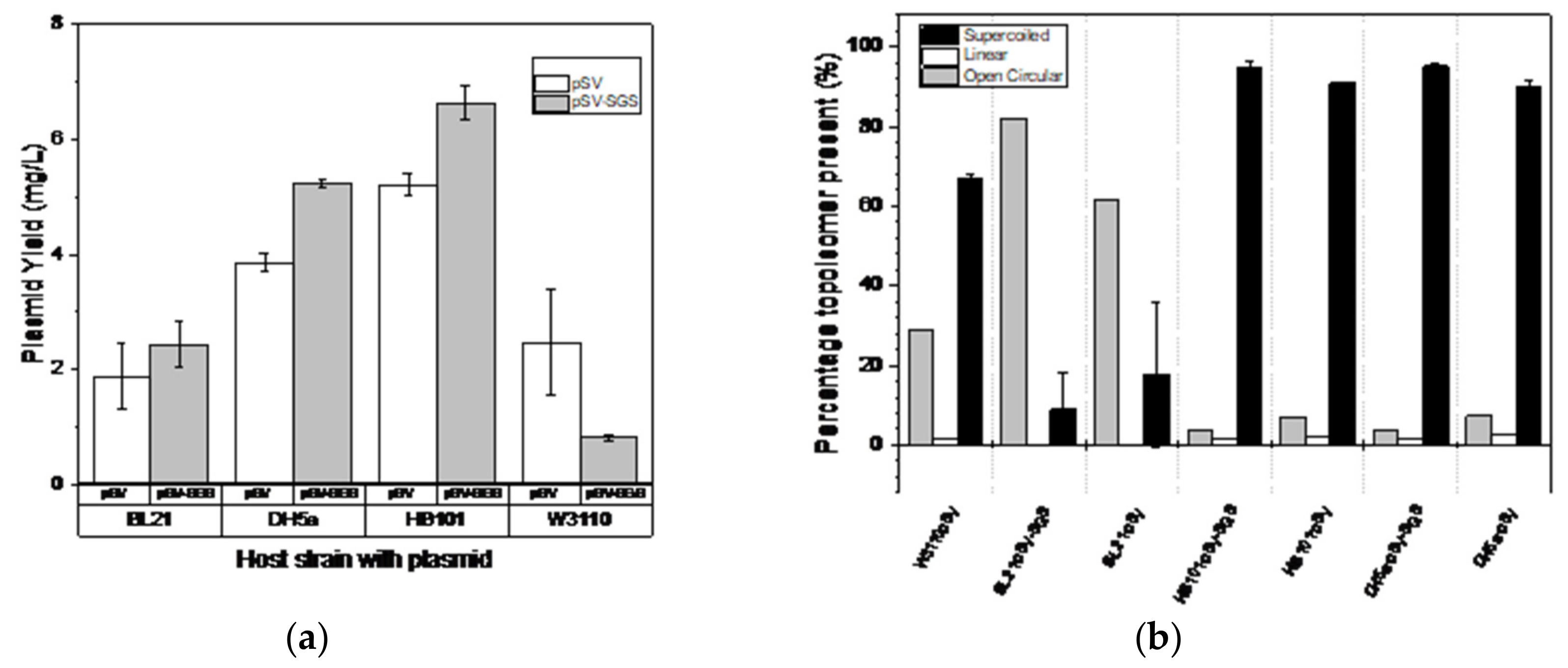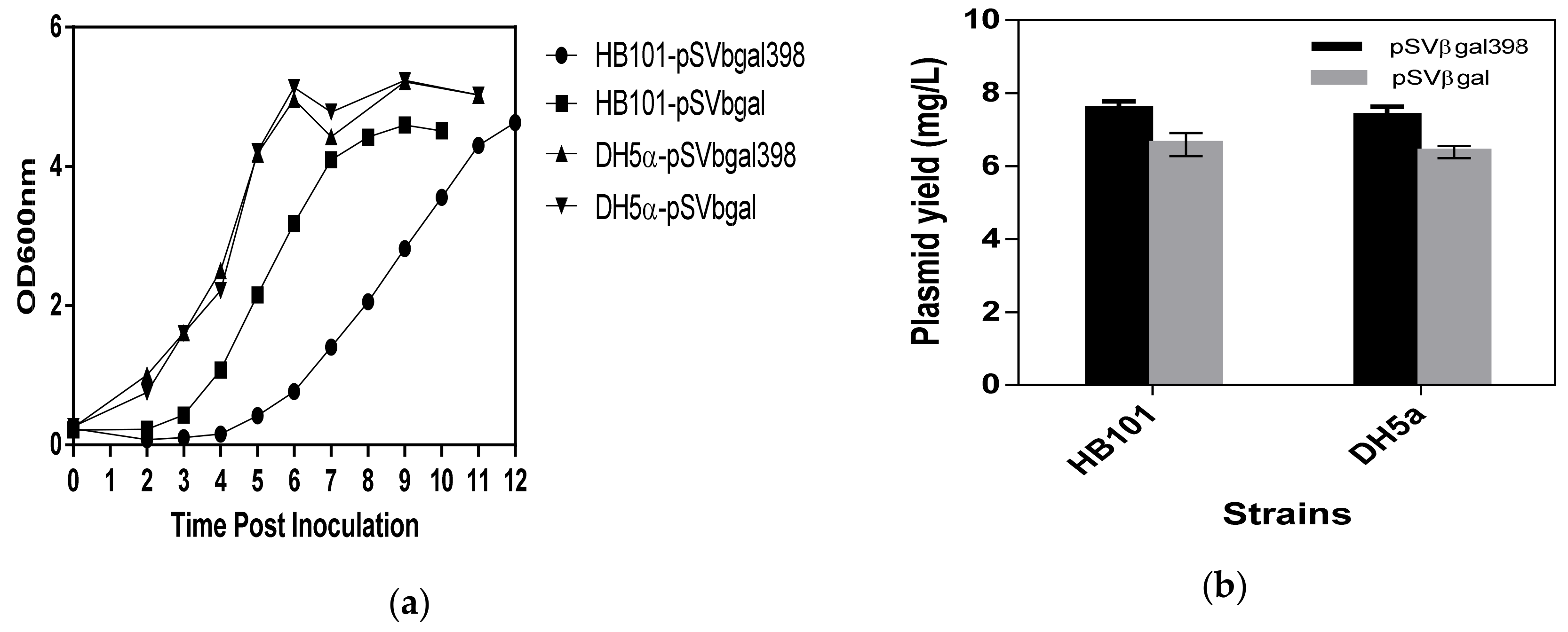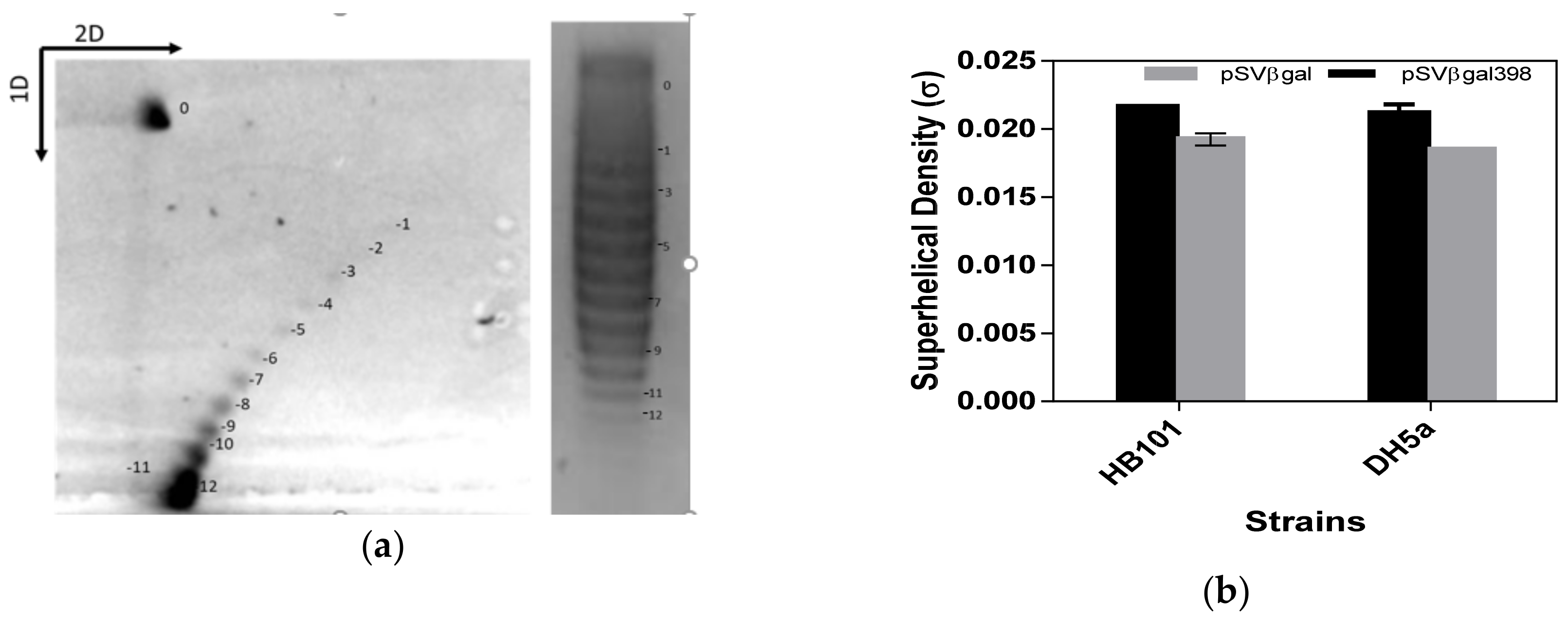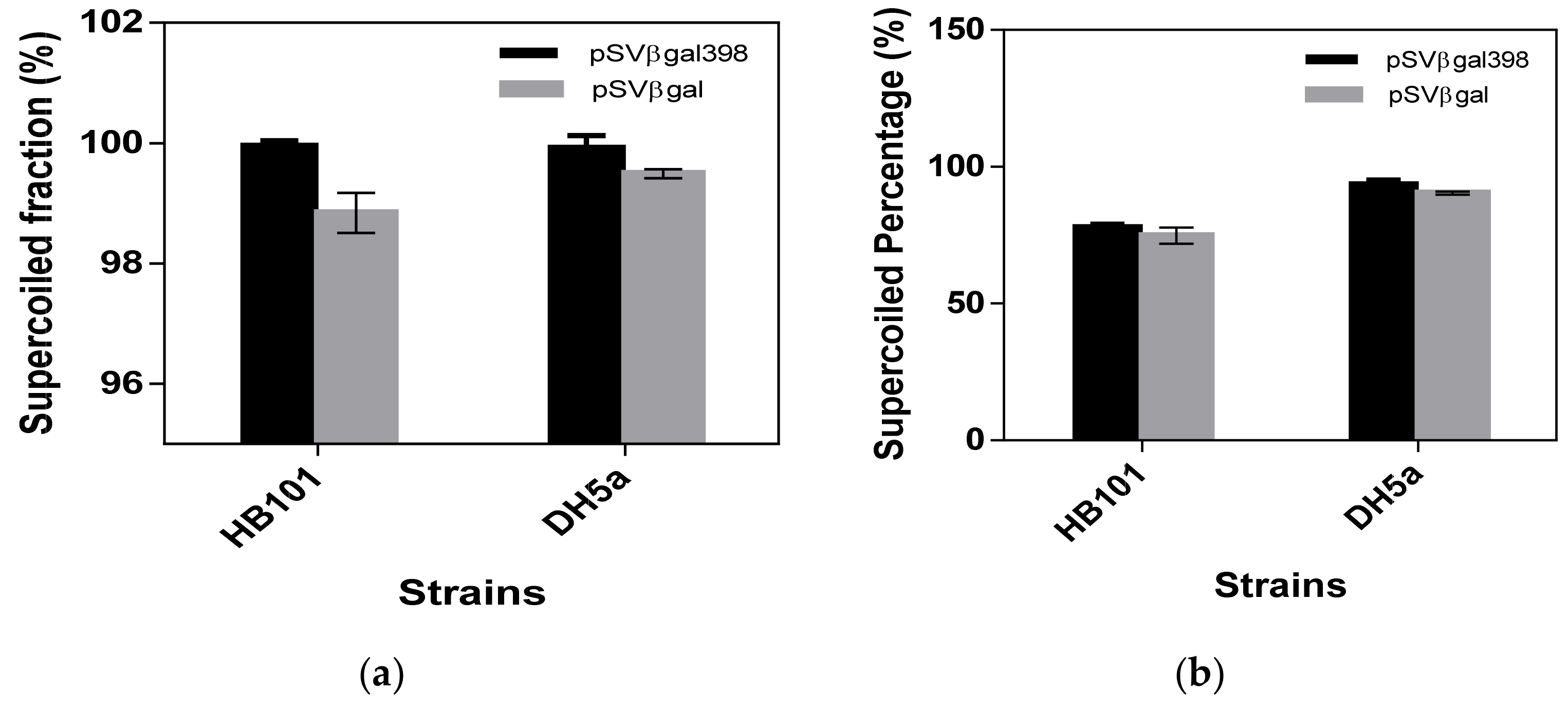Application of Plasmid Engineering to Enhance Yield and Quality of Plasmid for Vaccine and Gene Therapy
Abstract
1. Introduction
2. Materials and Methods
2.1. Strains amd Plasmids
2.2. Fermentation
2.3. Plasmid Extraction and Purification
2.4. Determination of Plasmid Topology
2.5. Determination of Plasmid Superhelical Density
2.6. Plasmid Shear Exposure Experiment
2.7. Plasmid Hydrodynamic Diameter
3. Results
3.1. Effects of SGS on Plasmid Yield and Supercoiling and Strain Selection
3.2. Effect of SGS Presence on the Superhelical Density of the Plasmid
3.3. Impact of Increase Supercoiling on Plasmid Integrity
3.4. Determination of Plasmid Compactness by Particle Hydrodynamic Diameter Measurement
4. Discussion
5. Conclusions
Author Contributions
Funding
Conflicts of Interest
References
- Brazolot, M.C.L.; Weeratna, R.; Krieg, A.M.; Siegrist, C.A.; Davis, H.L. CpG DNA can induce strong Th1 humoral and cell-mediated immune responses against hepatitis B surface antigen in young mice. Proc. Natl. Acad. Sci. USA 1998, 95, 15553–15558. [Google Scholar]
- Okuda, K.; Bukawa, H.; Hamajima, K.; Kawamoto, S.; Sekigawa, K.; Yamada, Y.; Tanaka, S.; Ishi, N.; Aoki, I.; Nakamura, M. Induction of Potent Humoral and Cell-Mediated Immune Responses Following Direct Injection of DNA Encoding the HIV Type 1 env and rev Gene Products. AIDS Res. Hum. Retroviruses. 1995, 11, 933–943. [Google Scholar] [CrossRef] [PubMed]
- Chandra, J.; Dutton, J.L.; Li, B.; Woo, W.P.; Xu, Y.; Tolley, L.K.; Yong, M.; Wells, J.W.; Leggatt, S.L.; Finlayson, N.; et al. DNA Vaccine Encoding HPV16 Oncogenes E6 and E7 Induces Potent Cell-mediated and Humoral Immunity Which Protects in Tumor Challenge and Drives E7-expressing Skin Graft Rejection. J. Immunother. 2017, 40, 62–70. [Google Scholar] [PubMed]
- Wiley. Gene Therapy Clinical Trials Worldwide [Internet]. J. Gene Med. 2016. Available online: http://www.wiley.com/legacy/wileychi/genmed/clinical/ (accessed on 13 March 2017).
- Monie, A.; Tsen, S.W.; Hung, C.F.; Wu, T.C. Therapeutic HPV DNA vaccines. Expert Rev. Vaccines 2009, 8, 1221–1235. [Google Scholar] [CrossRef] [PubMed]
- Pierini, S.; Perales-Linares, R.; Uribe-Herranz, M.; Pol, J.G.; Zitvogel, L.; Kroemer, G.; Facciabene, A.; Galluzzi, L. Trial watch: DNA-based vaccines for oncological indications. Oncoimmunology 2017, 6, e1398878. [Google Scholar] [CrossRef] [PubMed]
- Hobernik, D.; Bros, M. DNA Vaccines-How Far From Clinical Use? Int. J. Mol. Sci. 2018, 19, 3605. [Google Scholar] [CrossRef] [PubMed]
- Cupillard, L.; Juillard, V.; Latour, S.; Colombet, G.; Cachet, N.; Richard, S.; Blanchard, S.; Fischer, L. Impact of plasmid supercoiling on the efficacy of a rabies DNA vaccine to protect cats. Vaccine 2005, 23, 1910–1916. [Google Scholar] [CrossRef]
- Adamčík, J.; Víglasky’, V.; Valle, F.; Antalík, M.; Podhradsky’, D.; Dietler, G. Effect of bacteria growth temperature on the distribution of supercoiled DNA and its thermal stability. Electrophoresis 2002, 23, 3300–3309. [Google Scholar] [CrossRef]
- Lara, A.R.; Ramírez, O.T. Plasmid DNA production for therapeutic applications. Methods Mol. Biol. 2012, 824, 271–303. [Google Scholar]
- Gonçalves, G.L.; Prather, K.L.; Monteiro, G.A.; Carnes, A.E.; Prazeres, D.M. Plasmid DNA production with Escherichia coli GALG20, a pgi-gene knockout strain: Fermentation strategies and impact on downstream processing. J. Biotechnol. 2014, 186, 119–127. [Google Scholar] [CrossRef]
- Knabben, I.; Regestein, L.; Marquering, F.; Steinbusch, S.; Lara, A.R.; Büchs, J. High cell-density processes in batch mode of a genetically engineered Escherichia coli strain with minimized overflow metabolism using a pressurized bioreactor. J. Biotechnol. 2010, 150, 73–79. [Google Scholar] [CrossRef]
- Flores, S.; de Anda-Herrera, R.; Gosset, G.; Bolívar, F.G. Growth-rate recovery of Escherichia coli cultures carrying a multicopy plasmid, by engineering of the pentose-phosphate pathway. Biotechnol. Bioeng. 2004, 87, 485–494. [Google Scholar] [CrossRef] [PubMed]
- Cunningham, D.S.; Liu, Z.; Domagalski, N.; Koepsel, R.R.; Ataai, M.M.; Domach, M.M. Pyruvate kinase-deficient Escherichia coli exhibits increased plasmid copy number and cyclic AMP levels. J. Bacteriol. 2009, 191, 3041–3049. [Google Scholar] [CrossRef]
- O’Kennedy, R.D.; Baldwin, C.; Keshavarz-Moore, E. Effects of growth medium selection on plasmid DNA production and initial processing steps. J. Biotechnol. 2000, 76, 175–183. [Google Scholar] [CrossRef]
- Voss, C.; Schmidt, T.; Schleef, M.; Friehs, K.; Flaschel, E. Effect of ammonium chloride on plasmid DNA production in high cell density batch culture for biopharmaceutical use. J. Chem. Technol. Biotechnol. 2004, 79, 57–62. [Google Scholar] [CrossRef]
- Levy, M.S.; Collins, I.J.; Yim, S.S.; Ward, J.M.; Titchener-Hooker, N.; Shamlou, P.A.; Dunnill, P. Effect of shear on plasmid DNA in solution. Bioprocess Eng. 1999, 20, 7. [Google Scholar] [CrossRef]
- Zhang, H.; Kong, S.; Booth, A.; Boushaba, R.; Levy, M.S.; Hoare, M. Prediction of Shear Damage of Plasmid DNA in Pump and Centrifuge Operations Using an Ultra Scale-Down Device. Biotechnol. Prog. 2007, 23, 858–865. [Google Scholar] [CrossRef]
- Yau, S.Y.; Keshavarz-Moore, E.; Ward, J. Host strain influences on supercoiled plasmid DNA production in Escherichia coli: Implications for efficient design of large-scale processes. Biotechnol. Bioeng. 2008, 101, 529–544. [Google Scholar] [CrossRef]
- O’Kennedy, R.D.; Ward, J.M.; Keshavarz-Moore, E. Effects of fermentation strategy on the characteristics of plasmid DNA production. Biotechnol. Appl. Biochem. 2003, 37, 83. [Google Scholar] [CrossRef]
- Mizushima, T.; Kataoka, K.; Ogata, Y.; Inoue, R.; Sekimizu, K. Increase in negative supercoiling of plasmid DNA in Escherichia coli exposed to cold shock. Mol. Microbiol. 1997, 23, 381–386. [Google Scholar] [CrossRef]
- Hassan, S.; Keshavarz-Moore, E.; Ward, J. A cell engineering strategy to enhance supercoiled plasmid DNA production for gene therapy. Biotechnol Bioeng. 2016, 113, 2064–2071. [Google Scholar] [CrossRef] [PubMed]
- Champoux, J.J. DNA Topoisomerases: Structure, Function, and Mechanism. Annu. Rev. Biochem. 2001, 70, 369–413. [Google Scholar] [CrossRef] [PubMed]
- Snoep, J.L.; van der Weijden, C.C.; Andersen, H.W.; Westerhoff, H.V.; Jensen, P.R. DNA supercoiling in Escherichia coli is under tight and subtle homeostatic control, involving gene-expression and metabolic regulation of both topoisomerase I and DNA gyrase. Eur. J. Biochem. 2002, 269, 1662–1669. [Google Scholar] [CrossRef] [PubMed]
- Reece, R.J.; Maxwell, A.; Wang, J.C. DNA Gyrase: Structure and Function. Crit. Rev. Biochem. Mol. Biol. 1991, 26, 335–375. [Google Scholar] [CrossRef] [PubMed]
- Pato, M.L.; Banerjee, M. Replacement of the bacteriophage Mu strong gyrase site and effect on Mu DNA replication. J. Bacteriol. 1999, 181, 5783–5789. [Google Scholar] [PubMed]
- Morgan, G.J.; Hatfull, G.F.; Casjens, S.; Hendrix, R.W. Bacteriophage Mu genome sequence: Analysis and comparison with Mu-like prophages in Haemophilus, Neisseria and Deinococcus. J. Mol. Biol. 2002, 317, 337–359. [Google Scholar] [CrossRef] [PubMed]
- Huber, H.; Pacher, C.; Necina, R.; Kollmann, F.R.C. Method for producing plasmid DNA on a manufacturing scale by fermentation of the Escherichia coli K-12 strain JM108. World Patent WO/2005/098002, 21 October 2005. [Google Scholar]
- Borja, G.M.; Meza, M.E.; Barrón, B.; Gosset, G.; Ramírez, O.T.; Lara, A.R. Engineering Escherichia coli to increase plasmid DNA production in high cell-density cultivations in batch mode. Microb. Cell Fact. 2012, 11, 132. [Google Scholar] [CrossRef]
- Phue, J.N.; Lee, S.J.; Trinh, L.; Shiloach, J. Modified Escherichia coli B (BL21), a superior producer of plasmid DNA compared with Escherichia coli K (DH5alpha). Biotechnol. Bioeng. 2008, 101, 831–836. [Google Scholar] [CrossRef]
- Singer, A.; Eiteman, M.; Altman, E. DNA plasmid production in different host strains of Escherichia coli. J. Ind. Microbiol. Biotechnol. 2009, 36, 521–530. [Google Scholar] [CrossRef]
- Lahijani, R.; Hulley, G.; Soriano, G.; Horn, N.; Marquet, M. High-yield production of pBR322-derived plasmids intended for human gene therapy by employing a temperature-controllable point mutation. Hum. Gene Ther. 1996, 7, 1971–1980. [Google Scholar] [CrossRef]
- Sambrook, J.; Fritsch, E.F.; Maniatis, T. Molecular Cloning: A Laboratory Manual, 2nd ed.; Cold Spring Harbor Laboratory Press: New York, NY, USA.
- Studier, F.W.; Moffatt, B.A. Use of bacteriophage T7 RNA polymerase to direct selective high-level expression of cloned genes. J. Mol. Biol. 1986, 189, 113–130. [Google Scholar] [CrossRef]
- Grant, S.G.; Jessee, J.; Bloom, F.R.; Hanahan, D. Differential plasmid rescue from transgenic mouse DNAs into Escherichia coli methylation-restriction mutants. Proc. Natl. Acad. Sci. USA 1990, 87, 4645–4649. [Google Scholar] [CrossRef] [PubMed]
- Hanahan, D. Techniques for Transformation of E. coli. DNA Cloning: A Practical Approach; Glover, D.M., Ed.; IRL: Oxford, UK.
- Boyer, H.W.; Roulland-Dussoix, D. A complementation analysis of the restriction and modification of DNA in Escherichia coli. J. Mol. Biol. 1969, 41, 459–472. [Google Scholar] [CrossRef]
- Hayashi, K.; Morooka, N.; Yamamoto, Y.; Fujita, K.; Isono, K.; Choi, S.; Eiichi, O.; Tomoya, B.; Barry, L.; Hirotada, M.; et al. Highly accurate genome sequences of Escherichia coli K-12 strains MG1655 and W3110. Mol. Syst. Biol. 2006, 2. [Google Scholar] [CrossRef]
- Bowater, R.; Aboul-Ela, F.; Lilley, D.M. Two-dimensional gel electrophoresis of circular DNA topoisomers. Methods Enzymol. 1992, 212, 105–120. [Google Scholar] [PubMed]
- Rayat, A.C.; Chatel, A.; Hoare, M.; Lye, G.J. Ultra scale-down approaches to enhance the creation of bioprocesses at scale: impacts of process shear stress and early recovery stages. Curr. Opin. Chem Eng. 2016, 14, 150–157. [Google Scholar] [CrossRef]
- Hou, J.; Ci, H.; Wang, P.; Wang, C.; Lv, B.; Miao, L.; You, G. Nanoparticle tracking analysis versus dynamic light scattering: Case study on the effect of Ca2+ and alginate on the aggregation of cerium oxide nanoparticles. J. Hazard Mater. 2018, 360, 319–328. [Google Scholar] [CrossRef]
- Baranello, L.; Levens, D.; Gupta, A.; Kouzine, F. The importance of being supercoiled: How DNA mechanics regulate dynamic processes. BBA-Gene Regul. Mech. 2012, 1819, 632–638. [Google Scholar] [CrossRef]
- Witz, G.; Stasiak, A. DNA supercoiling and its role in DNA decatenation and unknotting. Nucleic Acids Res. 2009, 38, 2119–2133. [Google Scholar] [CrossRef]
- Hitchcock, A.G.; Sergeant, J.A.; Rahman, S.F.; Tharia, H.A.; Blom, H. Scale-Up of a Plasmid DNA Purification Process. BioProcess International. 2010, pp. 46–54. Available online: http://www.bioprocessintl.com/analytical/downstream-development/scale-up-of-a-plasmid-dna-purification-process-307226/ (accessed on 18 June 2019).
- Carnes, A.E. Fermentation Design for the Manufacture of Therapeutic Plasmid DNA. BioProcess Int. 2005. Available online: https://pdfs.semanticscholar.org/fc3a/044506b95c79b913a3536765a1ae4d9e2307.pdf (accessed on 18 June 2019).
- Duttweiler, H.M.; Gross, D.S. Bacterial growth medium that significantly increases the yield of recombinant plasmid. Biotechniques 1998, 24, 438–444. [Google Scholar] [CrossRef]
- Freitas, S.S.; Santos, J.A.L.; Prazeres, D.M.F.; Heinzle, E.; Biwer, A.P.; Cooney, C.L. Plasmid DNA. In Development of Sustainable Bioprocesses; John Wiley & Sons: Chichester, UK, 2006; pp. 271–285. [Google Scholar]
- Williams, J.A.; Luke, J.; Langtry, S.; Anderson, S.; Hodgson, C.P.; Carnes, A.E. Generic plasmid DNA production platform incorporating low metabolic burden seed-stock and fed-batch fermentation processes. Biotechnol. Bioeng. 2009, 103, 1129–1143. [Google Scholar] [CrossRef] [PubMed]
- Oram, M.; Howells, A.J.; Maxwell, A.; Pato, M.L. A biochemical analysis of the interaction of DNA gyrase with the bacteriophage Mu, pSC101 and pBR322 strong gyrase sites: The role of DNA sequence in modulating gyrase supercoiling and biological activity. Mol. Microbiol. 2003, 50, 333–347. [Google Scholar] [CrossRef] [PubMed]
- Pato, M.L.; Banerjee, M. Genetic analysis of the strong gyrase site (SGS) of bacteriophage Mu: localization of determinants required for promoting Mu replication. Mol. Microbiol. 2000, 37, 800–810. [Google Scholar] [CrossRef] [PubMed]
- Bettotti, P.; Visone, V.; Lunelli, L.; Perugino, G.; Ciaramella, M.; Valenti, A. Structure and Properties of DNA Molecules Over The Full Range of Biologically Relevant Supercoiling States. Sci. Rep. 2018, 8, 6163. [Google Scholar] [CrossRef] [PubMed]
- Diaz, R.J.C.; Hernández, M.E. Plasmid Effects on Escherichia coli Metabolism. Crit. Rev. Biotechnol. 2000, 20, 79–108. [Google Scholar] [CrossRef]
- Bolivar, F.; Backman, K. Plasmids of Escherichia coli as cloning vectors. Methods Enzymol. 1979, 64, 245–267. [Google Scholar]
- Langley, K.E.; Villarejo, M.R.; Fowler, A.V.; Zamenhof, P.J.; Zabin, I. Molecular basis of beta-galactosidase alpha-complementation. Proc. Natl. Acad. Sci. USA 1254, 72, 1254–1257. [Google Scholar] [CrossRef] [PubMed]
- Higgins, N.P.; Vologodskii, A.V. Topological Behavior of Plasmid DNA. Microbiol. Spectr. 2015, 3. [Google Scholar] [CrossRef]
- Koster, D.A.; Crut, A.; Shuman, S.; Bjornsti, M.A.; Dekker, N.H. Cellular Strategies for Regulating DNA Supercoiling: A Single-Molecule Perspective. Cell 2010, 142, 519–530. [Google Scholar] [CrossRef]
- Ferreira, G.N.M.; Monteiro, G.A.; Prazeres, D.M.F.; Cabral, J.M.S. Downstream processing of plasmid DNA for gene therapy and DNA vaccine applications. Trends Biotechnol. 2000, 18, 380–388. [Google Scholar] [CrossRef]
- Dhanoya, A.; Chain, B.M.; Keshavarz-Moore, E. The impact of DNA topology on polyplex uptake and transfection efficiency in mammalian cells. J. Biotechnol. 2011, 155, 377–386. [Google Scholar] [CrossRef] [PubMed]
- Weintraub, H.; Cheng, P.; Conrad, K. Expression of transfected DNA depends on DNA topology. Cell 1986, 46, 115–122. [Google Scholar] [CrossRef]
- Dhanoya, A.; Chain, B.M.; Keshavarz-Moore, E. Role of DNA topology in uptake of polyplex molecules by dendritic cells. Vaccine 2012, 30, 1675–1681. [Google Scholar] [CrossRef] [PubMed]
- Filipe, V.; Hawe, A.; Jiskoot, W. Critical evaluation of nanoparticle tracking analysis (NTA) by NanoSight for the measurement of nanoparticles and protein aggregates. Pharm. Res. 2010, 27, 769–810. [Google Scholar] [CrossRef] [PubMed]
- Mehrabi, K.; Nowack, B.; Arroyo Rojas Dasilva, Y.; Mitrano, D.M. Improvements in Nanoparticle Tracking Analysis to Measure Particle Aggregation and Mass Distribution: A Case Study on Engineered Nanomaterial Stability in Incineration Landfill Leachates. Environ. Sci. Technol. 2017, 51, 5611–5621. [Google Scholar] [CrossRef]






| Strain | Genotype | Source | Status |
|---|---|---|---|
| BL-21 | [34] | Commercial | |
| DH5α | [35,36] | Commercial | |
| HB101 | [37] | Non-commercial | |
| W3110 | [38] | Non-commercial |
| HB101 | DH5α | |||
|---|---|---|---|---|
| pSVβ-gal398 | pSVβ-gal | pSVβ-gal398 | pSVβ-gal | |
| Superhelical density | −0.0218 | −0.0192 | −0.0204 | −0.0185 |
| Hydrodynamic diameter | 39.53 ± 6.52 nm | 70.77 ± 8.84 nm | 56.97 ± 1.55 nm | 85.50 ± 7.19 nm |
| Compactness | 44% more compact | 34% more compact | ||
© 2019 by the authors. Licensee MDPI, Basel, Switzerland. This article is an open access article distributed under the terms and conditions of the Creative Commons Attribution (CC BY) license (http://creativecommons.org/licenses/by/4.0/).
Share and Cite
Folarin, O.; Nesbeth, D.; Ward, J.M.; Keshavarz-Moore, E. Application of Plasmid Engineering to Enhance Yield and Quality of Plasmid for Vaccine and Gene Therapy. Bioengineering 2019, 6, 54. https://doi.org/10.3390/bioengineering6020054
Folarin O, Nesbeth D, Ward JM, Keshavarz-Moore E. Application of Plasmid Engineering to Enhance Yield and Quality of Plasmid for Vaccine and Gene Therapy. Bioengineering. 2019; 6(2):54. https://doi.org/10.3390/bioengineering6020054
Chicago/Turabian StyleFolarin, Olusegun, Darren Nesbeth, John M. Ward, and Eli Keshavarz-Moore. 2019. "Application of Plasmid Engineering to Enhance Yield and Quality of Plasmid for Vaccine and Gene Therapy" Bioengineering 6, no. 2: 54. https://doi.org/10.3390/bioengineering6020054
APA StyleFolarin, O., Nesbeth, D., Ward, J. M., & Keshavarz-Moore, E. (2019). Application of Plasmid Engineering to Enhance Yield and Quality of Plasmid for Vaccine and Gene Therapy. Bioengineering, 6(2), 54. https://doi.org/10.3390/bioengineering6020054






